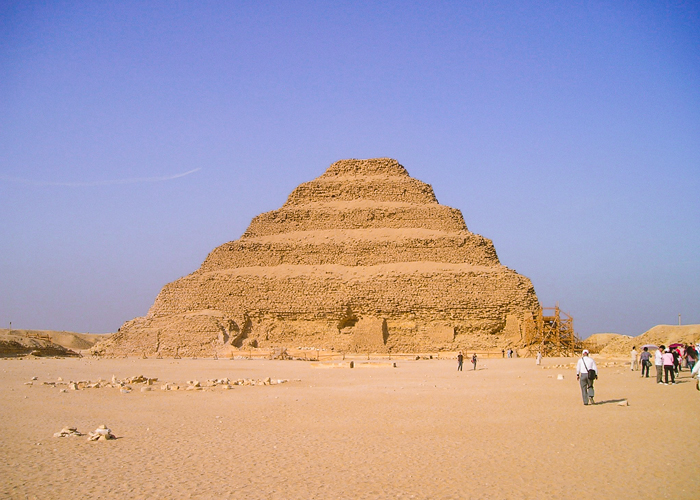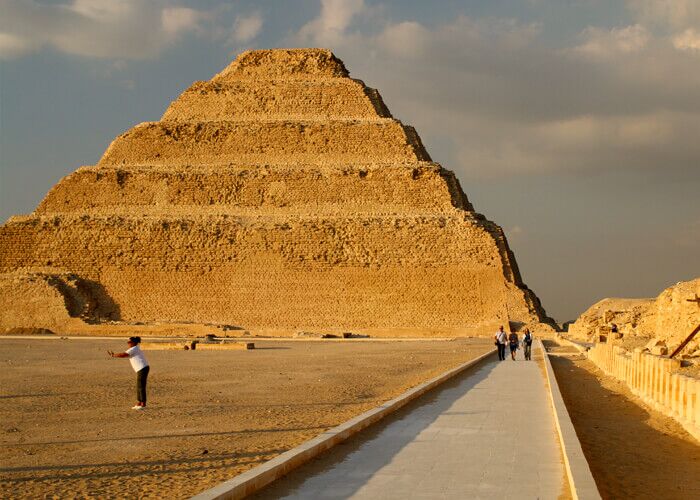Step Pyramid of Zoser: A Timeless Wonder of Saqqara
Introduction
Step Pyramid of Zoser stands as one of the most extraordinary achievements of ancient Egyptian civilization. It is not only the first monumental stone building in history but also the earliest pyramid ever constructed, marking a revolutionary stage in architecture. Built for King Zoser (also known as Djoser) during the 27th century BC, this pyramid rises proudly in the Saqqara necropolis near Memphis. Unlike later smooth-sided pyramids, the Zoser Pyramid is a stepped pyramid, composed of six layers that decrease in size as they ascend. For travelers exploring Egypt, the site offers an unmatched journey through time, combining archaeological significance, fascinating history, and the wonder of seeing the foundation of pyramid-building traditions.
The Vision of King Zoser and His Architect Imhotep
The pyramid was built during the reign of King Zoser, a ruler of Egypt’s Third Dynasty. Unlike earlier mudbrick tombs called mastabas, Zoser envisioned something far more monumental to reflect his power and divine connection. His chief architect, Imhotep, was a genius of his time. By stacking mastabas of diminishing size, he created what became the first step pyramid, a design that would inspire generations of pyramid builders.
Imhotep’s role is particularly important; he is considered the world’s first recorded architect and engineer. The Zoser Pyramid was not just a tomb but a statement of religious and political authority. Its design symbolized the pharaoh’s stairway to the heavens, a path to eternal life with the gods. For travelers today, learning about Imhotep’s innovation adds depth to their visit, as they stand before the earliest and most ambitious stone structure in history.

Architectural Features of the Step Pyramid
The pyramid of Zoser stands at a height of about 62 meters, dominating the Saqqara plateau. At first, it was meant to be a simple square mastaba, but through several modifications, it transformed into a six-tiered pyramid. This stepped pyramid is surrounded by a large rectangular enclosure wall that gives the impression of a royal palace.
The vast complex includes courtyards, shrines, temples, and ceremonial spaces, making it more than a tomb—it was a city for the afterlife. The enclosure measures around 545 meters long and 278 meters wide, containing elaborate stonework and symbolic decorations.
Inside the pyramid lies a labyrinth of passageways, chambers, and shafts. The burial chamber, carved deep underground, once held King Zoser’s sarcophagus. For travelers, exploring the scale and ingenuity of this construction makes it clear why this is regarded as one of the greatest engineering marvels of antiquity.
Religious and Symbolic Importance
The step pyramids were not merely architectural feats but deeply connected to the ancient Egyptians’ belief system. The Step Pyramid of Zoser represented a cosmic stairway. Each tier of the pyramid was seen as a step for the king’s soul to ascend to the heavens and join the sun god Ra.
Surrounding the pyramid were chapels for rituals, courts for festivals, and spaces for offerings, reinforcing the king’s eternal presence in both the divine and human world. The pyramid’s alignment to cardinal points reflects the Egyptians’ astronomical knowledge, emphasizing their quest for harmony between heaven and earth.
For modern travelers, this symbolic dimension adds richness to the visit. Standing before the pyramid, one can imagine the rituals, chants, and ceremonies that once filled the necropolis, transforming it into a sacred gateway between life and eternity.

Saqqara: The Setting of the Step Pyramid
The Step Pyramid of Zoser is located in Saqqara, Egypt’s oldest and most expansive necropolis. Saqqara served as the burial ground for Memphis, the first capital of Egypt. The desert plateau stretches over seven kilometers and houses numerous tombs, pyramids, and burial shafts spanning different dynasties.
Among these, the Zoser Pyramid is the centerpiece, attracting travelers and historians alike. Its presence highlights the beginning of pyramid-building traditions, which culminated in the smooth-sided Great Pyramids of Giza. Visitors exploring Saqqara can also see the Pyramid of Unas, with its Pyramid Texts, and mastaba tombs decorated with vivid reliefs that offer glimpses into daily life thousands of years ago.
Travelers will find Saqqara less crowded than Giza, providing a more intimate and atmospheric experience of ancient Egypt. The vast desert views, the timeless silence, and the grandeur of the Zoser Pyramid create an unforgettable journey.
The Step Pyramid in Comparison to Later Pyramids
One of the most fascinating aspects of the pyramid of Zoser is its role as the ancestor of later pyramids. Unlike the smooth-sided pyramids at Giza, this structure was built in steps. It represents the experimentation phase of ancient Egyptian engineering.
The pyramid’s height, about 62 meters, was impressive for its time, though later pyramids, like the Great Pyramid of Khufu at Giza, would reach over 146 meters. Yet, without the architectural innovations of the Zoser Pyramid, these later marvels would never have been possible.
For travelers, understanding this connection makes visiting both Saqqara and Giza deeply rewarding. By first experiencing the Step Pyramid of Zoser, one can appreciate how the evolution of pyramid design reflects both the technological progress and spiritual vision of ancient Egypt.
Exploring the Pyramid Complex Today
Today, visitors to Saqqara can walk through the entrance colonnade, a passage with forty stone columns leading into the vast courtyard of the complex. The surrounding walls give a sense of grandeur, while the open courtyards create spaces once used for festivals such as the Heb-Sed, a jubilee celebrating the pharaoh’s reign.
Inside the pyramid, restorations have made some chambers accessible, allowing travelers to witness the intricate underground architecture. Walking through these passageways gives a sense of mystery and connection to the ancient past.
For modern tourists, exploring the step pyramid is not just about history; it is about immersing oneself in a living monument that has endured for more than 4,600 years. Standing in the shadow of its massive stone steps, travelers feel the awe that generations have felt before them.
Practical Travel Tips for Visitors
For travelers planning to visit the Step Pyramid of Zoser, here are some practical tips to enhance the experience:
-
Best Time to Visit: Early morning or late afternoon offers cooler temperatures and softer light for photography.
-
Guided Tours: Hiring a knowledgeable guide helps uncover the rich history and symbolism of the complex.
-
What to Bring: Comfortable walking shoes, sun protection, and water are essential when exploring Saqqara’s desert environment.
-
Nearby Attractions: Combine your trip with visits to Memphis, the ancient capital, and Dahshur, home to the Bent Pyramid and the Red Pyramid.
By planning well, travelers can make the most of their visit and create lasting memories.
Why the Step Pyramid of Zoser Matters for Travelers
Visiting the Step Pyramid of Zoser is more than just a sightseeing stop; it is an opportunity to stand at the beginning of architectural history. It connects travelers to King Zoser, to Imhotep’s genius, and to the dawn of pyramid building. Unlike the crowded sites at Giza, Saqqara provides an authentic and atmospheric experience, allowing visitors to reflect on Egypt’s timeless legacy.
For those fascinated by history, architecture, or spirituality, the Zoser Pyramid offers a profound journey. It is the largest structure of its kind in Saqqara and continues to inspire wonder, making it one of Egypt’s most rewarding destinations.
Conclusion
The Step Pyramid of Zoser is more than just the pyramid of Saqqara; it is the foundation of Egypt’s monumental legacy. Rising in six majestic steps, it marks the moment when human ingenuity met divine ambition, creating the world’s first stone pyramid. For travelers, standing before this ancient wonder is a reminder of how Egypt’s past continues to shape its present, offering endless fascination and inspiration.
Exploring the stepped pyramid, visitors walk in the footsteps of kings, priests, and builders who lived nearly five millennia ago. Whether you are passionate about history, seeking authentic experiences, or simply drawn to Egypt’s timeless treasures, the Step Pyramid of Zoser is a destination that belongs on every traveler’s journey.

